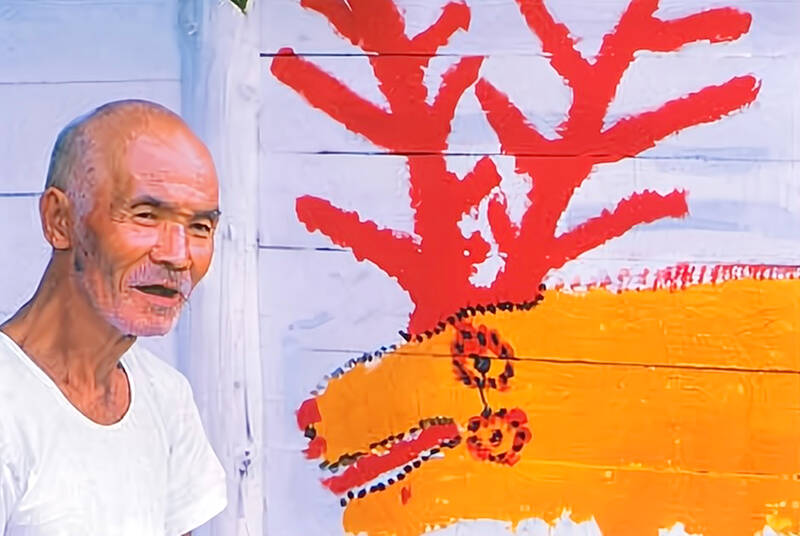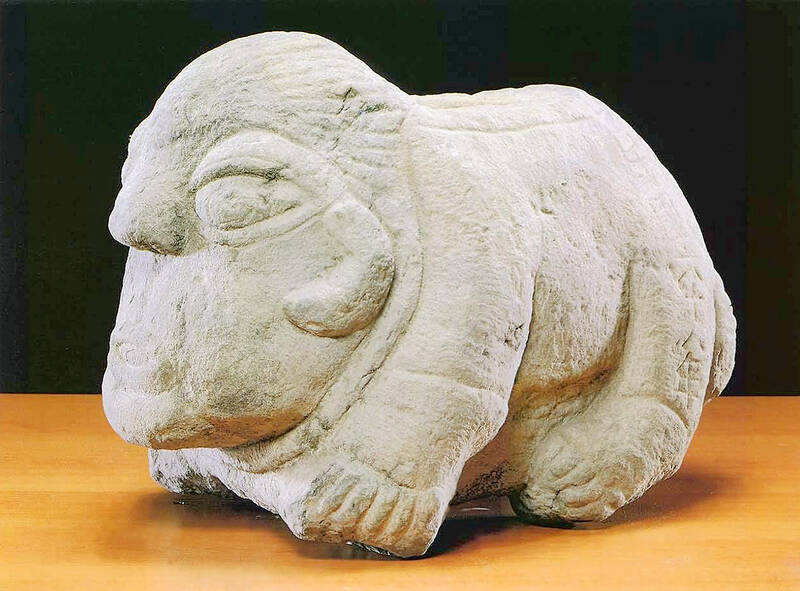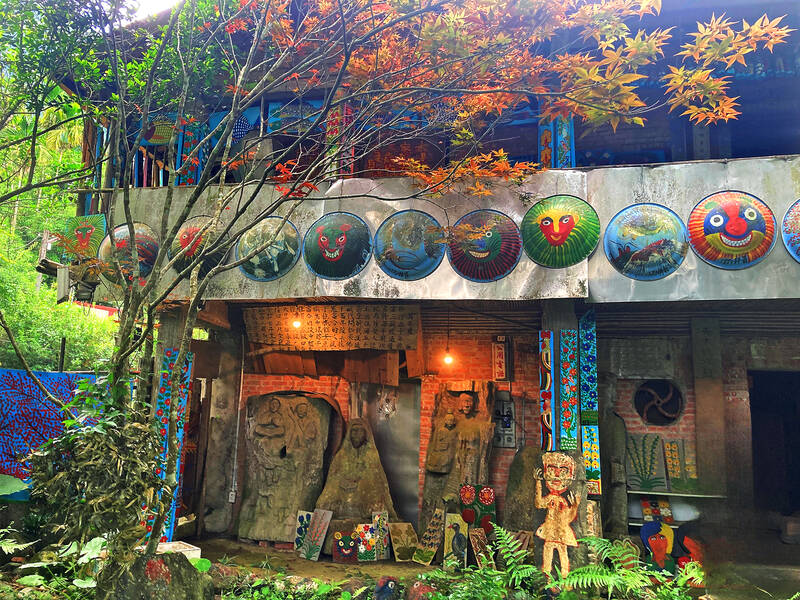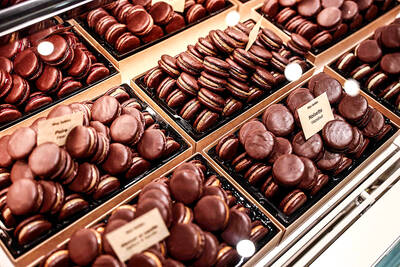Nov.10 to Nov.16
As he moved a large stone that had fallen from a truck near his field, 65-year-old Lin Yuan (林淵) felt a sudden urge. He fetched his tools and began to carve.
The recently retired farmer had been feeling restless after a lifetime of hard labor in Yuchi Township (魚池), Nantou County. His first piece, Stone Fairy Maiden (石仙姑), completed in 1977, was reportedly a representation of his late wife.

Photo courtesy of Taiwan Arts.edu
This version of how Lin began his late-life art career is recorded in Nantou County historian Teng Hsiang-yang’s (鄧相揚) 2009 biography of him. His expressive work eventually caught the attention of a local magazine, who invited newspaper reporters to visit in April 1980.
Early reports often compared Lin to Hung Tung (洪通), another untrained laborer who suddenly took up painting at the age of 50 and sparked a national craze several years earlier (see “Taiwan in Time: Brief stardom of the ‘Mad Artist,’”Feb. 19, 2023). Lin tried to visit Hung in 1981, but the reclusive Hung refused to see him.
Lin remained prolific until his death in 1991, leaving behind at least 10,000 works spanning sculpture, painting, drawing, installation and embroidery. Often signing his works as a “genius,” his motto was, “No political party, no artistic style, only my own ideas.” (無黨無派,自我思想).

Photo courtesy of Taiwan Arts.edu
LIFE OF LABOR
Born in 1913, Lin spent his entire life in the rural settlement of Jiadaokeng (加道坑) in Nantou County. His parents were poor tenant farmers, and he had a sickly elder brother and mentally disabled younger brother to care for. After his mother died when he was five, he began helping with chores such as cooking, planting vegetables, feeding livestock and cowherding.
Lin didn’t start school until the age of 11, and he had to quit just two months later due his elder brother’s death. He later taught himself how to write his name, some basic characters and numbers, which often feature in his drawings.

Photo courtesy of Taiwan Arts.edu
He began farming at 15, but as tenant farmers, his family could barely scrape by. Lin also did odd jobs such as stone cutting, construction, coffin board cutting and camphor oil processing. When there was no work, he gathered firewood, vines and shoulang yams and carried them to Puli (埔里) — a three hour round trip on foot — to sell, often making multiple trips a day. To save money, he often made his own tools, developing a fine craftsmanship and understanding of different materials.
At 23, Lin married Chen Chiu-mei (陳秋梅), convincing her reluctant father that he would treat her well and paying the bride price in installments. They had eight children, with Lin breaking conventions by personally delivering the last six after observing the midwife.
Lin continued to show his resourcefulness during hard times, and finally at the age of 32 was able to buy the land his family farmed on.

Photo courtesy of Taiwan Arts.edu
ARTISTIC AWAKENING
Chen died in 1968. Lin never remarried, raising his children alone. After his original house was destroyed in a flood, he bought new land and built a three-sided courtyard home.
His children convinced him to retire in 1977. At first, he entertained himself by crafting toys for his grandchildren, but that same year, he began sculpting. His son was supportive, even helping him find more stones to work on. Curious villagers gathered to watch, chiding him as a fool who didn’t choose a more lucrative hobby.

Photo courtesy of Bureau of Cultural Heritage
But Lin lost himself in his art. Soon his entire property, and even the roadsides nearby, were scattered with his figurative sculptures depicting all sorts of animals, people and historical or mythical figures.
By that time, the Hung Tung craze was on the downswing. “Discovered” in 1972, Hung’s rise coincided with the “nativist movement” (鄉土運動), which championed local culture and identity as Taiwan’s international status declined. As writers turned to realism to depict everyday Taiwanese life, musicians ventured to rural areas to document traditional folk songs. Hung’s destitute background and reputation as an eccentric, self-taught genius fit right in, culminating in several high profile exhibitions in 1976. However, Hung shunned the spotlight and retreated to his village soon after.
In 1978, county councilor Huang Ping-sung (黃炳松) founded the community magazine Puli Local Life (埔里鄉情). Two years later, magazine board member Chan Yuan-ho (詹元和) noticed Lin’s sculptures while delivering goods in the area. Chan informed Huang upon returning to Puli, and on April 9, 1980, they visited Lin with a United Daily News reporter. Huang was enamored with the work, buying everything — 53 stone sculptures and eight wood carvings — for about NT$30,000 apiece.
SECOND HUNG TUNG?
Lin’s fame spread after the United Daily News published an article the following day, describing his art as “rustic and unpretentious,” and dubbing him the “second Hung Tung.”
Media outlets flocked to the remote hamlet, and Huang also invited master sculptors Chu Ming (朱銘) and Yang Ying-feng (楊英風) to meet Lin; both praised his work.
Chu Ming reportedly told Huang in a stern tone, “Lin Yuan must be given space for pure creation — both in his mindset and surroundings. He must never be distracted by worldly fame or fortune, and you must not put any restrictions on his creative freedom. Just provide him with materials and let him create freely.”
On July 20, 1980, Lin’s work was displayed for the first time in the garden of Puli mayor Chou Hsien-wen (周顯文). He created a special piece for the occasion, depicting the 1930 Wushe Incident, an anti-Japanese uprising by the Indigenous Seediq that was brutally suppressed.
That winter, Lin traveled abroad for the first time, visiting South Korea and Japan with Huang. Lin was particularly inspired by Hokkaido’s Showa Shinzan volcanic dome, and upon returning home he visited his son-in-law’s factory to obtain screws and scrap metal, producing his first installation within a few days.
In the following years, Lin’s reputation spread internationally, and French painter Jean Debuffet donated photographs of his work to the Collection de L’Art Brut in Lausanne. On Nov. 12, 1982, Lin had his first solo show in Taipei’s Spring Gallery, followed by exhibitions in Taichung, Tainan and Hong Kong.
In 1984, Huang began creating the New Era Sculpture Park in Puli. Lin traveled there daily, creating several large-scale works as well as more than 1,000 smaller sculptures, installations, wood carvings and paintings. It opened to the public in 1987.
Lin continued exhibiting and creating until his death from pancreatic cancer in September 1991. Eight years later, both his studio and the park were severely damaged in the 921 Earthquake. The park has since evolved into a resort and spa, featuring a museum dedicated to Lin.
Taiwan in Time, a column about Taiwan’s history that is published every Sunday, spotlights important or interesting events around the nation that either have anniversaries this week or are tied to current events.

Many people noticed the flood of pro-China propaganda across a number of venues in recent weeks that looks like a coordinated assault on US Taiwan policy. It does look like an effort intended to influence the US before the meeting between US President Donald Trump and Chinese dictator Xi Jinping (習近平) over the weekend. Jennifer Kavanagh’s piece in the New York Times in September appears to be the opening strike of the current campaign. She followed up last week in the Lowy Interpreter, blaming the US for causing the PRC to escalate in the Philippines and Taiwan, saying that as

This year’s Miss Universe in Thailand has been marred by ugly drama, with allegations of an insult to a beauty queen’s intellect, a walkout by pageant contestants and a tearful tantrum by the host. More than 120 women from across the world have gathered in Thailand, vying to be crowned Miss Universe in a contest considered one of the “big four” of global beauty pageants. But the runup has been dominated by the off-stage antics of the coiffed contestants and their Thai hosts, escalating into a feminist firestorm drawing the attention of Mexico’s president. On Tuesday, Mexican delegate Fatima Bosch staged a

Taiwan can often feel woefully behind on global trends, from fashion to food, and influences can sometimes feel like the last on the metaphorical bandwagon. In the West, suddenly every burger is being smashed and honey has become “hot” and we’re all drinking orange wine. But it took a good while for a smash burger in Taipei to come across my radar. For the uninitiated, a smash burger is, well, a normal burger patty but smashed flat. Originally, I didn’t understand. Surely the best part of a burger is the thick patty with all the juiciness of the beef, the

Would you eat lab-grown chocolate? I requested a sample from California Cultured, a Sacramento-based company. Its chocolate, not yet commercially available, is made with techniques that have previously been used to synthesize other bioactive products like certain plant-derived pharmaceuticals for commercial sale. A few days later, it arrives. The morsel, barely bigger than a coffee bean, is supposed to be the flavor equivalent of a 70 percent to 80 percent dark chocolate. I tear open its sealed packet and a chocolatey aroma escapes — so far, so good. I pop it in my mouth. Slightly waxy and distinctly bitter, it boasts those bright,